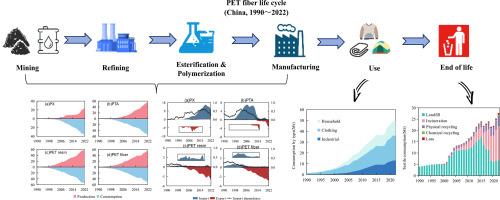Substance flow analysis of polyethylene terephthalate (PET) fiber in China
IF 11.2
1区 环境科学与生态学
Q1 ENGINEERING, ENVIRONMENTAL
引用次数: 0
Abstract
The flow process of polyethylene terephthalate (PET) fibers presents complex characteristics that are challenging to quantify accurately. This study quantified the flow patterns of PET fiber production, consumption, trade, and recycling during 1990–2022 and analyzed the effects of the economy, technology, and policy on the metabolic processes of PET fiber. Key findings are as follows: (1) the consumption and export of PET fiber showed an exponential growth trend due to rapid economic growth, accession to WTO, and technological progress since 2001; (2) the production of PET fiber decreased slightly during 2016–2018, affected by high-quality transformation of industry and the elimination of backward production capacity policies; (3) the increases in recycled PET fiber input after 2019, due to carbon peak, carbon neutral, and circular economy policies, have affected the formation of a new pattern of PET flow and resulted in new opportunities and challenges for the development of PET industry.

中国聚对苯二甲酸乙二酯(PET)纤维的物质流分析
聚对苯二甲酸乙二醇酯(PET)纤维的流动过程呈现出复杂的特征,难以准确量化。本研究量化了 1990-2022 年间 PET 纤维生产、消费、贸易和回收的流动模式,并分析了经济、技术和政策对 PET 纤维新陈代谢过程的影响。主要结论如下(1)2001年以来,受经济快速增长、加入WTO、技术进步等因素影响,PET纤维的消费和出口呈现指数级增长趋势;(2)2016-2018年,受产业高质量转型和淘汰落后产能政策影响,PET纤维产量略有下降;(3)2019年以后,受碳峰值、碳中和、循环经济等政策影响,再生PET纤维投入增加,影响PET流动新格局的形成,为PET产业发展带来新的机遇和挑战。
本文章由计算机程序翻译,如有差异,请以英文原文为准。
求助全文
约1分钟内获得全文
求助全文
来源期刊

Resources Conservation and Recycling
环境科学-工程:环境
CiteScore
22.90
自引率
6.10%
发文量
625
审稿时长
23 days
期刊介绍:
The journal Resources, Conservation & Recycling welcomes contributions from research, which consider sustainable management and conservation of resources. The journal prioritizes understanding the transformation processes crucial for transitioning toward more sustainable production and consumption systems. It highlights technological, economic, institutional, and policy aspects related to specific resource management practices such as conservation, recycling, and resource substitution, as well as broader strategies like improving resource productivity and restructuring production and consumption patterns.
Contributions may address regional, national, or international scales and can range from individual resources or technologies to entire sectors or systems. Authors are encouraged to explore scientific and methodological issues alongside practical, environmental, and economic implications. However, manuscripts focusing solely on laboratory experiments without discussing their broader implications will not be considered for publication in the journal.
 求助内容:
求助内容: 应助结果提醒方式:
应助结果提醒方式:


